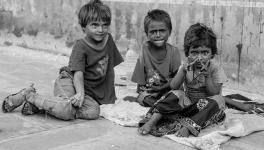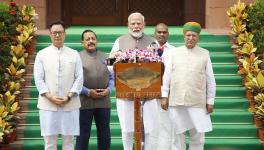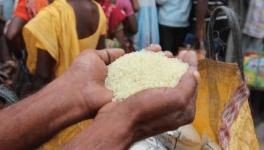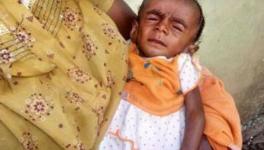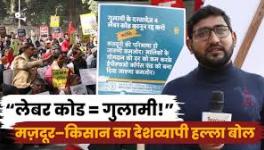Modi Govt’s Bizarre Unconcern with Hunger and Poverty
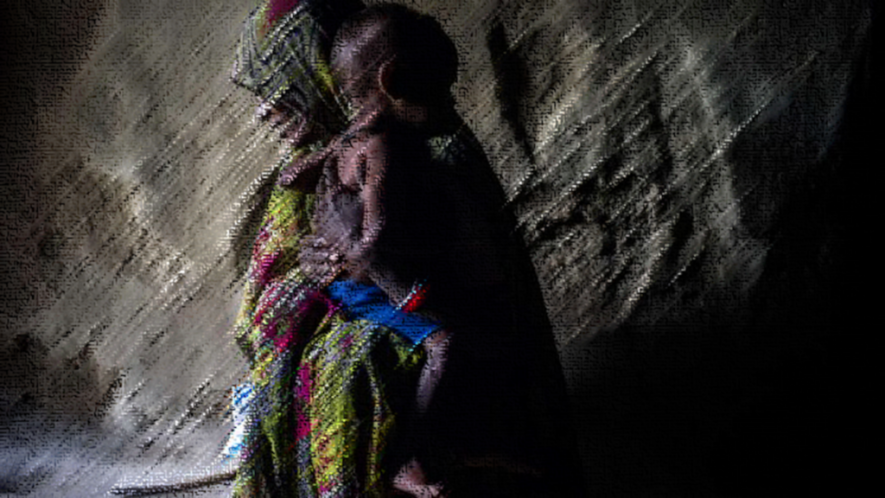
Representational image. | Image Courtesy: The Print
The news that India’s rank in 2019, according to the Global Hunger Index (GHI), was 102nd among the 117 countries for whom this index was calculated (it is not calculated for countries where hunger is not a problem), instead of causing consternation as it should have, has generated a rather inconsequential debate. This debate ironically has been concerned with two issues.
One is whether India’s rank, which was 55 in 2014, has fallen dramatically to 102 in 2019. And the second, where the NITI Aayog has been an active participant, whether the direction of change in India with regard to the components that go into the GHI has been right.
On the first issue, it has been argued that, since countries with a GHI score less than 5 (even after leaving aside the rich countries which are not covered anyway) have sometimes been included within the list of countries and sometimes shown separately, no conclusions can be drawn about a slippage in India’s precise ranking.
In fact India’s rank was 55 out of 76 countries in 2014, which slipped to 80 (out of 104 countries) in 2015, 97 (out of 118) in 2016, 100 (out of 119) in 2017, 103 (out of 119) in 2018 and 102 (out of 117) in 2019. And the GHI reports themselves say that “Rankings and index scores from this table cannot be accurately compared to rankings and index scores from previous reports.”
As for the NITI Aayog’s argument that no matter what the rank the country occupies, the direction of change has been right, i.e, that the individual components which make up the hunger index, have, each of them, been showing an improvement over time, this is just a sleight of hand.
The GHI incorporates four different components: under-nourishment (inadequate calorie intake for the population as a whole), child “wasting” (the proportion of children under 5 who are “wasted”, i.e have lower weights for their heights), child stunting (the proportion of children under 5 who have low weights for their age), and child mortality (the mortality rate among children less than 5).
The NITI Aayog uses the findings of the Comprehensive National Nutrition Survey (CNNS) to argue its case that the direction of movement has been right. But the CNNS is a survey of just one point of time. Hence the NITI Aayog’s conclusion is based on comparing the CNNS with a previous survey undertaken by another organisation; and the comparability between the two is questionable.
Besides, it does not even cover all the different components of the GHI. The first component of the GHI, it may be recalled, concerns the calorie intake for the population as a whole. What has been happening to this calorie intake over time is not revealed by any of the currently available official data sources.
The National Sample Survey used to systematically undertake a large sample survey every five years that obtained information about expenditures by households on various items of consumption and on the basis of that information worked out the calorie intake of these sample households. Between the quinquennial surveys it also used to undertake annual surveys covering a smaller sample of households.
The NSS quinquennial surveys, incidentally, were among the largest sample surveys undertaken anywhere in the world and constituted the main data source for researchers on various aspects of the Indian economy. But the latest year for which such survey data are available until now is 2011-12. Since then no NSS data for calorie intake have appeared; what has happened to the NSS under the Bharatiya Janata Party government remains a mystery.
If the NITI Aayog was really serious about its argument, that in India the direction of movement with regard to hunger was right, then it should have had the courage to restore the NSS to its rightful position as a data source, instead of using all sorts of incomplete information with questionable comparability to make an essentially ideological point.
Now, leaving aside all these debates, there are two unambiguous conclusions which can be drawn from the GHI for 2019. The first is that among all the South Asian countries, India has the lowest rank in terms of the GHI in 2019. And the second is that there has been an alarming rise in the prevalence of child “wasting” (i.e the proportion of children under 5 who are underweight relative to their height, reflecting acute under-nutrition), between 2010 and 2019.
These two unambiguous conclusions have a profound significance. Let alone Sri Lanka and Bangladesh, even Nepal, which is among the poorest countries in the world and is categorised by the United Nations as one of the “Least Developed Countries”, has a GHI score that is higher than India. Likewise, even Pakistan which is currently afflicted by a serious economic crisis, has a higher GHI score than India. Earlier, India had a score higher than Pakistan; but in 2019 that ordering has been reversed.
India, prior to the recent slowdown, has been claiming to be an “emerging economic superpower”; and for a while, when India’s rate of GDP growth even exceeded that of China, making it the fastest growing economy of the world (no matter what the veracity of the GDP estimates and hence of this claim), the BJP government never let the country hear the last of it. And yet this “emerging economic superpower” has a hunger index that is even worse than of poor Nepal.
How can we explain this bizarre unconcern with hunger and poverty of the people?
Capitalism, of course, is immanently a mode of production that generates wealth at one pole and poverty at another (it is no surprise that Cuba has a GHI of less than 5); but the level of callousness of the ruling establishment towards the conditions of the common people goes beyond what capitalism alone dictates.
For instance, during the very period when hunger has been so acute, India has been sitting on vast amounts of foodgrain stocks and even making large foodgrain exports. If these foodgrains could have been used for the people’s consumption, then we could have brought down the extent of hunger in the country quite significantly. Why does this not happen?
The level of callousness by the ruling establishment towards the conditions of the common people not only goes beyond what capitalism per se would dictate, but even exceeds what prevails in other countries. There are, in short, specifically Indian roots of this callousness; and one such root obviously is the caste system. If those belonging to the dalit and other “backward” castes are not even considered “equal” to the upper castes, then this very institutionalised inequality militates against any sympathy being shown towards them; and they largely constitute the poor.
In other words, we have a social structure where the inequality engendered by the capitalist system is superimposed upon the inequality institutionalised by the caste system to generate a brew of callousness that is unparalleled anywhere in the world. This fact has become particularly manifest under the rule of the Hindutva forces; they manipulate the dalits and other backward castes to get their electoral support while being utterly niggardly with respect to any State expenditure for improving their lot.
The recent fiscal measures that the government has announced for stimulating the economy only underscore this point. An obvious measure which would not only have stimulated the economy but also made a dent in poverty and hunger, would have been to enlarge welfare expenditures, whether on education or on healthcare or on MGNREGS. But this government did none of these; it gave away instead Rs 1.45 lakh crore of corporate tax concessions, to no purpose, to India’s super-rich!
Nothing illustrates better the phoney-ness of the BJP’s “hyper-nationalism” than the fact that the very government that prides itself on a high gross domestic product growth does not bat an eyelid when the country occupies the 16th rank from the bottom among all the countries of the world in the matter of hunger. And its top advisory body, the NITI Aayog, is perfectly satisfied claiming (no matter with what little justification) that the direction of movement is right!
Get the latest reports & analysis with people's perspective on Protests, movements & deep analytical videos, discussions of the current affairs in your Telegram app. Subscribe to NewsClick's Telegram channel & get Real-Time updates on stories, as they get published on our website.













